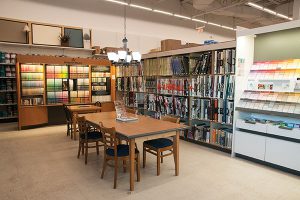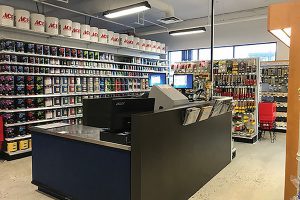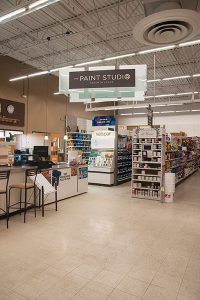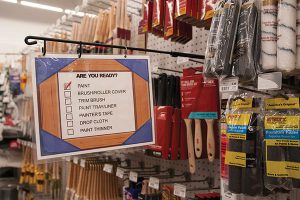
Click the picture to download a PDF of this story.
By Chad Husted, chusted@nrha.org
‘Help Me, Help You’
A paint department can be a beautiful focal point for any home improvement retailer. For the customer, paint brings a bright, vibrant display of colors to a store, but it’s not all aesthetics for them or the retailer.
Paint gives possibilities. A customer walking into a great paint department isn’t thinking about the most practical item they need to accomplish a task. Paint can open up creative avenues for each customer, giving life to a project they discovered online or have been mulling each time they’ve entered a room they want to transform.
Retailers can latch on to that creative spirit with their own innovative takes on their paint and sundries departments. Developing a strong paint department requires focus on several factors, from industry knowledge and product selection to unique merchandising methods and relevant events.
To offer a refreshing take on changes in paint and sundries in 2018, Hardware Retailing spoke with retailers at two independent home improvement businesses that have devoted significant time and energy to the category.

Tim Doehrmann and Stan DesCarpentrie have done more than feature the paint department at Tim’s Ace Hardware and Interiors Roecker’s in Peoria, Illinois. The store on the north edge of Peoria is the combination of Tim’s Ace, which opened in 2006, and Interiors Roecker’s, a paint and sundries supply store that has been serving the area since 1942. In 2011, the businesses merged together, with Roecker’s owner DesCarpentrie becoming the new manager at Tim’s Ace. The business has placed paint at the front of its future—quite literally. The paint department is what customers see first when they walk into the store.
Another business that has invested heavily in paint is Cloverdale Ace Hardware, a retail location that is part of the larger Fraser Valley Building Supply (FVBS) company. The business also includes several Fraser Valley RONA stores and the FVBS Contractor Division, says FVBS president Ray Cyr.
Cyr and paint and commercial sales specialist Jim Dojack have placed Cloverdale Ace in a strong position for paint and sundries in the Surrey, British Columbia, region with connections to paint professionals and DIY consumers.
These retailers have seen the changes and advancements made in the paint and sundries category over time and offered their takes on how best to serve the modern paint customers as well as supplying the ambitious projects they are taking on.

Aiding in Adventure
By its creative nature, paint can be both an exciting prospect and an intimidating task. Technique and hard-earned skills can play a larger factor in painting than other DIY and home improvement projects.
While professionals will always have their place in the market, more homeowners are taking on tasks themselves and are looking to retailers as sources for not just products but also advice and guidance, Dojack says. These adventurous DIY consumers can come into stores with great enthusiasm about a project, which gives a retailer a strong chance for the sale if they can keep pace with the technologies and materials used in paint and applicators.
These can include the newest brushes with bristles designed for specific paints or knowledge about products across the price spectrum and how they can be used to complete projects.
“Consumers are more educated than ever in paint,” Dojack says. “Before, we as the paint experts were saying what was trendy and the customer had no way of knowing whether that was accurate. Now, they’re coming into the store and dictating what the trends are, so we have to do our homework.”
Bring in professionals to educate interested DIYers and employees through in-store demonstrations. Partnering with paint professionals to educate staff and customers can boost your business and theirs.
DIYers often find projects online on websites like Pinterest, Dojack says, but they come into the store expecting to be able to just point out a color or technique, walk out with a bucket and be ready to go.
“Our customers know what they want, but websites that are offering this information are only taking the customer halfway. They’re not helping the customer wrap up the entire project from start to finish,” Dojack says. “That’s where we have to translate for the customer. ‘How will this paint look when it’s in your home, with the light the way you want it? It won’t look in person like it does on your computer screen.’”

In the paint category, knowledge and training is highly important for retail employees. Bring in professionals to educate interested DIYers and employees through in-store demonstrations. Partnering with paint professionals to educate staff and customers can boost your business and theirs.
At Tim’s Ace Hardware and Interiors Roecker’s, manager DesCarpentrie uses his paint expertise in a number of ways. Not only can he be an in-store resource for customers and a sounding board for pros, but he has established a service for Tim’s Ace in which he makes in-home visits to help customers with design decisions.
The home visits allow DesCarpentrie to display the color palette where it will live, Doehrmann says.
“The paint color is, of course, affected by what’s around it, and it’s not just DesCarpentrie bringing the colors out,” Doehrmann says.
“He has an eye for design that many don’t have and he can offer expert opinions on floor coverings and countertops that will play off of color choices. Customers from all over ask him for in-home visits.”
The service also works as a connection to contractors. Tim’s Ace can provide the paint a customer needs, but the entire design might require a contractor to finish.
“When I end up helping with things like countertop design selection, that may not help us increase sales,” DesCarpentrie says. “But it sets up a long-term relationship with a customer. Customers who are painting a room might install a new light fixture or upgrade their molding. There’s add-on potential with paint.”

Keeping Options Open
With options in paint and sundries growing each year, being able to offer a larger variety of price points will be paramount in coming months. Options include products that combine paint and primer in one formulation, low-VOC paints and specialty items like milk-based paints for specific projects.Tim’s Ace offers multiple lines of paint, Doehrmann says. Having the higher-quality paints is necessary to be considered a real go-to paint store, he says, but going directly to those items isn’t always in the best interest of the customer. Lower-priced paints can accomplish similar tasks, and if a retailer is familiar with the paints involved, they can assist a customer in keeping their project within budget.
“We’re all about the truth when it comes to paint selection and what price a customer should be looking for. When you tell the customer the truth, they know you’re invested in their project and not just a potential sale,” Doehrmann says.
Being able to serve trends at every price point is how you attract repeat business.”
—Stan DesCarpentrie, Tim’s Ace Hardware and Interiors Roecker’s
When a customer comes in with a specific project, such as a faux finish on reclaimed furniture for a distressed look that DesCarpentrie has seen continue to grow, starting at the bottom of the price point and working up allows the customer to see the options they have to achieve the project. Or, if it isn’t a specific project the customer is attempting, the choice to select a more eco-friendly paint that will accomplish the same task leaves a lasting impression in a customer’s mind.
“We don’t want the customer to be the one to say, ‘Stop, I need to go less expensive.’ We’ll take them up through the price points and explain just what kind of result you’ll get with each option. Some people want to go right to the top, and that’s fine if they know what they want and don’t mind the cost. But being able to serve trends at every price point is how you attract repeat business,” DesCarpentrie says.

Get the Latest App(licator)
While retailers must be ready to assist customers attempting new design trends through education and training, the customer won’t be able to finish the project of their applicators aren’t compatible with the type of paint those chose. Understanding the right tools is one of the latest tasks retailers are contending with at Cloverdale Ace and other paint-focused stores, Cyr says.
Paint customers might be more educated about design and color options than ever before, but the applicator technology will often be very foreign to DIYers, he says. Bristle technology and the proper method of application are more varied than most customers know, and it falls to the retailer to make this clear.
“A big part of the responsibility of the store employee, especially for DIYers, is getting the appropriate sundries to complete the job. You want to make sure you’re selling the whole package when you have this customer in your store,” Cyr says. “Nothing is more frustrating for the customer than not having the right tools when they get home.”
Cyr cites the shift to acrylic paints in recent years as one product advancement that has affected business, but a more recent change has been on the applicator side of the category. There are now more options, and more specialized products, than ever before.
“The technology has really evolved on the applicator side of things to match the advances in the paint. Edging tools and sundries are now much more advanced and specialized,” Cyr says.
DesCarpentrie looks to another example with some of the more high-end paints offered at Tim’s Ace. Not only do those paints react differently to brushes than more common paint, but even the method of application is altered by the characteristics of the paint. With more customers taking on projects themselves, this kind of applicator knowledge will become more of a focus.

Some paints go on heavier than others, which means they’ll have greater coverage. Yet DesCarpentrie has seen professionals that think they’re laying it on too heavy. Heavier paints also need a microfiber brush in order to hold more product on the bristles and to keep the paint even as it is applied.
“These are all things that customers never really had to think about before, so it’s a change in the industry,” DesCarpentrie says.
At Cloverdale Ace, Dojack is also seeing an evolution of applicators with new brushes being designed to achieve a smoother finish with fewer applications. He looks to manufacturers making hollow-point brushes as an example of this change.
By having the whole package, you’re able to put that room together. You do one, they’re wowed, then they come back for more rooms.
—Stan DesCarpentrie, Tim’s Ace Hardware and Interiors Roecker’s
Zero-VOC paints are often incompatible with older brushes and applicators. When a modern product can save a customer time and money, there’s a greater likelihood of a combo sale.
“Older paints used five coats compared to two with these new brushes and advanced paints,” Dojack says. “I just saved a customer a day of painting and money on another can. That’s the goal for long-term business.”

Color Selector
Trendy colors often come full circle, as can design themes that fall out of favor and are later revived with a new generation. Retailers are seeing consumers make stronger, bolder color choices and pairing them with wallpaper and other wallcoverings as a focal point.
Tim’s Ace carried wallpaper selections even as wallcoverings became less popular, and they’ve recently seen a resurgence in use. In DesCarpentrie’s home visits, he sometimes uses wallcoverings in combination with paint to create rooms that have received strong receptions from customers.
“By having the whole package, you’re able to put that room together. You do one, they’re wowed, then they come back for more rooms. That helps us sell paint, sundries and wallcoverings again,” DesCarpentrie says.
In paint color trends, recent choices include a move to whites and grays of different intensities, Doehrmann says.
“The Midwest is usually a few years behind the coasts on those things, and whites have been strong on the coast for a while. Grays are still strong, but lighter versions are really getting traction. The off-whites are different as well. People are looking less to the yellow styles of off-white and to more cooler shades,” Doehrmann says.
Bright colors that have sometimes dominated interior design in past years will continue to be in the customer palette, Dojack says, but as feature pieces. Wallcoverings have been used similarly in recent years.
“Trends are heading toward classic combinations, but more subdued, simple and low key,” Dojack says.
Since paint can be such an emotional decision for customers, Dojack says a retailer can get a feel for why a customer is choosing a particular shade, and he believes the current mood of many consumers is leaning toward calm spaces.
“Paint can be a very personal business, far more than other departments in a hardware or home improvement store. You establish close relationships,” Dojack says. “Color choice is being made with that in mind, which is why I think you’re going to see these calmer colors showing up more often.”
 Hardware Retailing The Industry's Source for Insights and Information
Hardware Retailing The Industry's Source for Insights and Information








